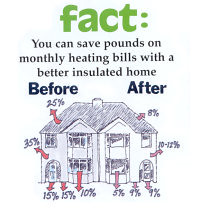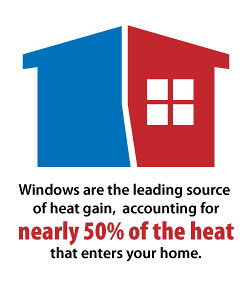Heat Proof Your Home
Don’t pay to heat the sky! Without proper insulation, more than half your home’s heat can escape through your roof and gaps in walls, windows, doors and floors. Draught proofing can be quick and simple to do — you just need to walk around your home to identify where drafts are getting in and then follow our easy guide to the best materials to use to block up any gaps. Insulating your roof and walls can make a huge difference to both the temperature of your home and the size of your fuel bills. This will not only help to keep you warmer in winter — but also cooler when the weather is hot. You can buy materials to insulate your loft that you can fit yourself, or call in professionals to do the whole job for you. Wall insulation isn’t generally a DIY job, so you will need expert advice and installation. Click here for more details.
Loft Insulation & how to do it YOURSELF!
You can lose as much as third of your home’s heat through your roof *. So fitting loft insulation is a simple and cost effective way to cut fuel bills. Loft insulation acts like a blanket, preventing rising heat escaping from your home. If you are interested in getting loft insulation npower can provide a complete service. You may even be entitled to free loft insulation, or a grant to help with some of the cost. Click here to find out more about insulation. If you are looking to fit loft insulation yourself: Buy insulation roll that’s the recommended 270mm depth. Cover all the floor space of your loft, including any joists that are visible. Be sure not to insulate below the cold water tank, if you have one. To provide safe access for storage — or to get to your cold water tank — you can then fit boards over the insulation material to walk over. Protective clothing, gloves and masks should be worn while fitting your insulation.
Wall Insulation
Insulating the walls of your home can reduce your heating bills by up to 20% * as well as helping to keep you warmer inside (and cooler during the summer months). There are different kinds of wall insulation and the best one for you will depend on the construction of your home.
Cavity wall insulation: this is suitable if your home has cavity walls, which applies to most properties built since the 1930s. A cavity wall is, as the name suggests, where a cavity (or small air gap) exists between an outer and inner layer of bricks or blocks on your home’s external walls. To reduce heat escaping through these walls, it’s possible to fill this gap with insulating materials. Fitting cavity wall insulation is a job for professionals, but only takes about half a day and all work from companies registered with the Cavity Insulation Guarantee Agency (CIGA) is guaranteed for 25 years. You may be entitled to free cavity wall insulation, or a grant to help with some of the cost. Alternatively we provide competive prices on CIGA approved installation. Click here to find out more about insulation.
Insulation for solid walls: most homes built before the 1930s are constructed with solid rather than cavity walls. Solid walls tend to let even more heat escape, so insulating these can have a big impact on keeping your home warmer and your fuel bills lower. It’s possible to insulate solid walls from either the inside or outside. From the inside, thermal boards (made of plaster board backed with insulating material) can be fitted, or a cavity can be made using timber battens and plasterboard. It’s possible to do this yourself if you are very handy, or you can get professional help to do it for you. From the outside, there are a range of materials that can be fitted — such as render, tiles or stone cladding. This can be especially useful if your external walls are in poor condition. Planning permission may be necessary if your home is listed. A specialist insulation fitter will be able to advise.
Draught Proofing
Blocking up gaps and holes where draughts get in and heat escapes is a quick and easy way to save energy and reduce your home heating bills (it will also keep you warmer and block out noise). Play draught detective and walk around your home checking all the windows, external doors and floors in each room for gaps where heat can escape.
Don’t forget that boilers and gas or coal fires need ventilation, so don’t block up air bricks or ventilation outlets that exist to serve these.
Insulating doors and windows. Fit a draught strip’ around your doors and windows. There are a variety to choose from — for example, self adhesive compressed foam can be fitted in strips and costs around £1-£5 a reel. If you have gaps around door or window frames that aren’t uniform in size, a fin seal may be more appropriate than foam strips. Silicon rubber tubing is useful for filling gaps without making doors or windows difficult to close — it can also be painted to blend in with your colour scheme. Put a flap behind your letter box on the inside of your door to restrict cold air getting in. If you have large key holes on external doors, fit a cover on the inside — again to block out cold air. The ultimate draft proofing for windows is double glazing — while it requires a large investment, it will significantly reduce heat loss and add value to your home.
Insulating floors and walls
Carpet with a thick underlay keeps more heat in a room than bare floor boards. But filling the gaps in between floor boards — either with a silicon sealant or a mixture of sawdust and glue (to retain an authentic look) — will also help to reduce heat loss. Sawdust can usually be purchased from floor sanding companies (or save your own if you are also sanding your floors yourself).
Check around skirting boards and fill in any gaps with silicon sealant or foam compression seals.
Source: Energy Saving Trust 2007 http://www.npower.com/At_home/Go_green/Energy_savings/Building_fabrics.html





5 Comments
Satyender Goswami · March 25, 2008 at 7:31 am
Hi Heena,
Heatproof home is really a interesting concept, I am from India and looking for the homes which remain cool in summers. At my place the summer temperature reach to 45’C. I am looking for solution to keep the temperature down.
harish · May 2, 2010 at 2:26 pm
Heat Proof Your Home
Draught Proofing
Loft Insulation
Insulating floors and walls
where shall i get these products
Heena Modi · May 6, 2010 at 4:34 pm
Perhaps ask NPower (the source of the post) or DIY places, such as, B & Q
Paul · July 12, 2010 at 4:52 pm
I just wanted to mention that if you wanted to go down the grant route for insulation CERT (carbon emissions reduction target) funding has been extended until December 2012
Heena Modi · July 18, 2010 at 1:40 pm
Thanks Paul
Comments are closed.